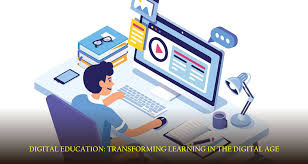Technology has revolutionized the education landscape, transforming how students learn and how teachers instruct. From online resources to advanced tools like artificial intelligence (AI) and virtual reality (VR), technology in education is making learning more accessible, engaging, and personalized. In this article, we explore the pivotal role of technology in education and its far-reaching impacts.
1. Personalized Learning Through Adaptive Technologies Technology in Education
Technology allows for personalized learning experiences tailored to individual student needs. Adaptive learning platforms like Khan Academy and DreamBox analyze a student’s performance and adjust content to match their pace and level.
Key Benefits:
- Enhances student engagement.
- Improves retention with customized content.
SEO Tip: Keywords – personalized learning, adaptive learning platforms, tailored
2. Online Learning and E-Learning Platforms in
Online learning has gained immense popularity, especially in the wake of the COVID-19 pandemic. Platforms like Coursera, Udemy, and Edmodo offer courses and resources accessible from anywhere, bridging the gap for remote learners.
Key Benefits:
- Increases accessibility for underserved communities.
- Offers flexibility for self-paced learning.
SEO Tip: Keywords – online learning platforms, e-learning benefits, remote
3. Gamification and Interactive Learning Tools Technology in Education
Gamification incorporates game elements into education, such as points, leaderboards, and rewards. Tools like Kahoot! and Quizizz make learning interactive and fun, boosting student motivation and participation.
Key Benefits:
- Enhances engagement through competition.
- Encourages active participation.
SEO Tip: Keywords – gamification in education, interactive learning tools, educational games
4. Virtual Reality (VR) and Augmented Reality (AR)
VR and AR provide immersive learning experiences, allowing students to explore complex concepts visually. For instance, VR can take students on virtual field trips, while AR overlays digital content in the real world.
Key Benefits:
- Improves understanding of abstract topics.
- Makes learning experiential and memorable.
SEO Tip: Keywords – virtual reality in education, AR in classrooms, immersive learning tools
5. Artificial Intelligence (AI) Technology in Education
AI is playing a crucial role in automating administrative tasks, enabling teachers to focus more on instruction. AI-powered tools like chatbots and virtual tutors assist students with instant feedback and support.
Key Benefits:
- Simplifies administrative work for educators.
- Provides 24/7 assistance to students.
SEO Tip: Keywords – AI in education, virtual tutors, artificial intelligence tools for learning
6. Collaborative Learning via Technology
Digital tools enable collaboration among students and teachers across the globe. Platforms like Google Classroom and Microsoft Teams facilitate group projects, discussions, and file sharing.
Key Benefits:
- Encourages teamwork and communication.
- Connects learners from diverse backgrounds.
SEO Tip: Keywords – collaborative learning tools, digital classrooms, technology-enabled teamwork
7. Bridging the Digital Divide Technology in Education
While in offers numerous benefits, the digital divide remains a challenge. Efforts to provide devices, internet access, and digital literacy training are crucial to ensuring all students benefit.
Key Benefits:
- Reduces educational inequality.
- Expands access to quality education.
SEO Tip: Keywords – digital divide in , bridging gaps, equitable access to edtech
8. Challenges and the Future of EdTech
Despite its advantages, technology in education faces challenges such as cybersecurity threats, data privacy issues, and over-reliance on screens. Addressing these concerns is key to ensuring technology enhances education sustainably.
Future Trends:
- Blockchain for secure credentialing.
- AI-driven personalized assessments.
SEO Tip: Keywords – future of edtech, challenges in educational technology, technology trends in education
Conclusion
Technology in education is reshaping the way we teach and learn, making education more engaging, accessible, and efficient. By embracing innovative tools and addressing challenges, educators can leverage technology to unlock new opportunities for students worldwide.
Optimized Meta Description: Explore how technology in education, from AI to VR, is transforming learning and making it more accessible, engaging, and personalized.
Would you like additional insights on a specific technology or examples of its application in education?
